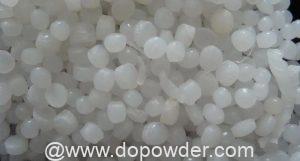Physical And Chemical Properties of Polyethylene Resin

Physical And Chemical Properties of Polyethylene Resin
Chemical Properties
Polyethylene has good chemical stability and is resistant to dilute nitric acid, dilute sulfuric acid and any concentration of hydrochloric acid, hydrofluoric acid, phosphoric acid, formic acid, acetic acid, ammonia water, amines, hydrogen peroxide, sodium hydroxide, potassium hydroxide, etc. solution. But it is not resistant to strong oxidative corrosion, such as fuming sulfuric acid, concentrated nitric acid, chromic acid and sulfuric acid mixture. At room temperature, the above-mentioned solvents will slowly erode polyethylene, while at 90-100°C, concentrated sulfuric acid and concentrated nitric acid will rapidly erode polyethylene, causing it to be destroyed or decomposed. Polyethylene is easy to be photo-oxidized, thermally oxidized, decomposed by ozone, and easily degraded under the action of ultraviolet rays. Carbon black has excellent light shielding effect on polyethylene. Reactions such as cross-linking, chain scission, and formation of unsaturated groups can occur after irradiation.
Mechanical properties
The mechanical properties of polyethylene are general, the tensile strength is low, the creep resistance is not good, and the impact resistance is good. Impact strength LDPE>LLDPE>HDPE, other mechanical properties LDPE crystallinity and relative molecular weight, with the improvement of these indicators, its mechanical properties increase. Environmental stress cracking resistance is not good, but when the relative molecular weight increases, it improves. Good puncture resistance, among which LLDPE is the best.
Environmental characteristics
Polyethylene is an alkane inert polymer with good chemical stability. It is resistant to corrosion by acid, alkali and salt aqueous solutions at room temperature, but not resistant to strong oxidants such as oleum, concentrated nitric acid and chromic acid. Polyethylene is insoluble in common solvents below 60°C, but will swell or crack in long-term contact with aliphatic hydrocarbons, aromatic hydrocarbons, halogenated hydrocarbons, etc. When the temperature exceeds 60℃, it can be dissolved in a small amount in toluene, amyl acetate, trichloroethylene, turpentine, mineral oil and paraffin; when the temperature is higher than 100℃, it can be dissolved in tetralin.
Since polyethylene molecules contain a small amount of double bonds and ether bonds, sun exposure and rain will cause aging, which needs to be improved by adding antioxidants and light stabilizers.
Processing characteristics
Because LDPE and HDPE have good fluidity, low processing temperature, moderate viscosity, low decomposition temperature, and do not decompose at high temperature of 300 ℃ in inert gas, they are plastics with good processing performance. However, the viscosity of LLDPE is slightly higher, and the motor power needs to be increased by 20% to 30%; it is prone to melt fracture, so it is necessary to increase the die gap and add processing aids; the processing temperature is slightly higher, up to 200 to 215 °C. Polyethylene has low water absorption and does not require drying before processing.
Polyethylene melt is a non-Newtonian fluid, and its viscosity fluctuates less with temperature, but decreases rapidly with the increase of shear rate and has a linear relationship, among which LLDPE has the slowest decrease.
Polyethylene products are easy to crystallize during the cooling process, therefore, attention should be paid to the mold temperature during processing. In order to control the crystallinity of the product, so that it has different properties. Polyethylene has a large molding shrinkage, which must be considered when designing the mold.
Physical And Chemical Properties of Polyethylene Resin
